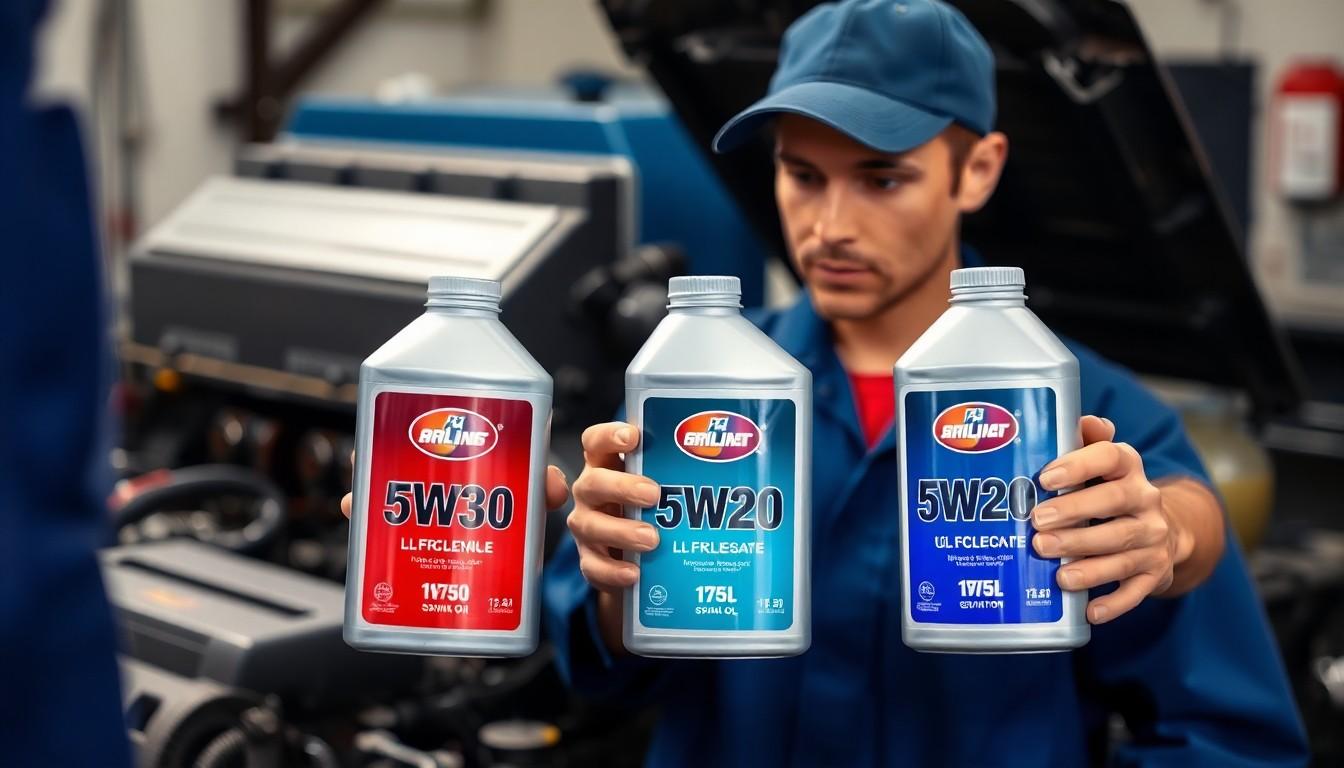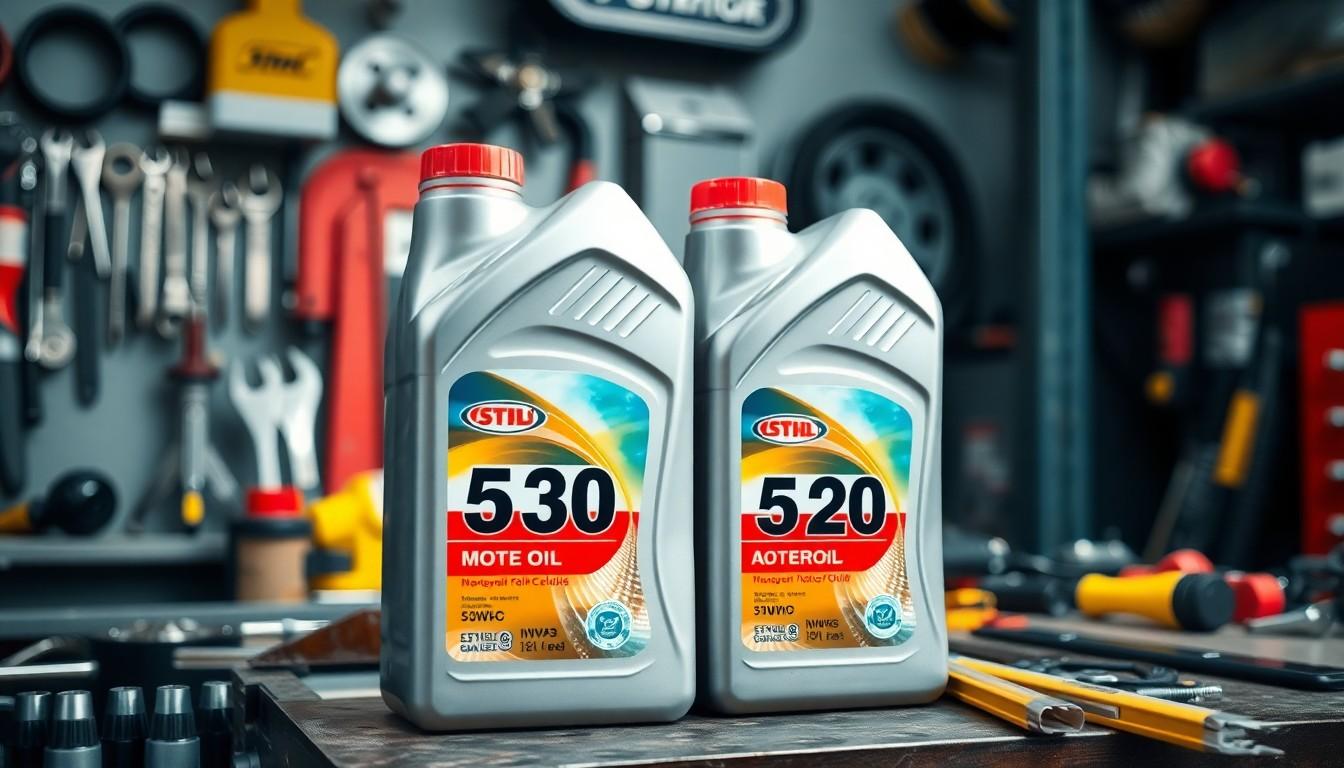Ever found yourself at the auto store staring at two different bottles of oil, wondering if mixing 5W30 and 5W20 will damage your engine? You’re not alone. This common dilemma affects many vehicle owners who are caught between what they have on hand and what their car manual recommends.
We’ve all been there—low on oil with only mixed viscosities available, or perhaps trying to transition between different oil types. While many mechanics have strong opinions on this topic, we’ll cut through the confusion with straightforward facts about these two popular motor oil grades and whether combining them is a practical solution or a costly mistake for your vehicle’s health.
Understanding Motor Oil Viscosity Ratings
Motor oil viscosity ratings tell us how thick or thin an oil is at different temperatures, which affects how well it protects your engine. These ratings are standardized by the Society of Automotive Engineers (SAE) and appear as numbers followed by the letter “W” on oil containers.
What Do 5W20 and 5W30 Designations Mean
The 5W20 and 5W30 designations represent exact viscosity characteristics of motor oil. The first number “5W” indicates the oil’s flow capability at low temperatures (the “W” stands for Winter). Both oils have the same cold weather performance, flowing easily during cold starts and providing immediate protection. The second numbers “20” and “30” refer to the oil’s thickness at high temperatures (212°F/100°C). Lower numbers mean thinner oil at operating temperature, so 5W20 is thinner than 5W30 when your engine heats up.
Key Differences Between 5W20 and 5W30
5W20 and 5W30 oils differ primarily in their high-temperature viscosity properties. 5W20 offers less resistance at operating temperatures, resulting in slightly better fuel economy—typically 1-2% improvement compared to 5W30. Engine manufacturers like Ford, Honda, and Toyota often recommend 5W20 for newer vehicles to help meet fuel efficiency standards. 5W30 provides thicker protection at high temperatures, making it ideal for older engines, high-performance vehicles, or driving in hot climates. 5W30 creates a stronger oil film between moving parts, offering additional protection during heavy loads or sustained high speeds. The viscosity difference translates to real-industry performance impacts: 5W20 flows more quickly through narrow passages and reduces internal friction, while 5W30 maintains better film strength under pressure or high heat conditions.
Can You Mix 5W30 and 5W20 Oil

Yes, you can mix 5W30 and 5W20 motor oil without causing immediate damage to your engine. These two viscosity grades are compatible enough to blend without important concerns, though they do have distinct characteristics. The viscosity difference between them is relatively minimal, making them suitable for mixing when necessary.
Short-Term Emergency Mixing
Emergency situations sometimes require pragmatic answers when it comes to your vehicle’s oil levels. Adding 5W30 to a 5W20 system (or vice versa) is significantly better than allowing your engine to run with insufficient oil. Many mechanics agree that topping off with a slightly different viscosity oil is preferable to driving with dangerously low oil levels, which can cause severe engine damage. This mixed solution works effectively as a temporary fix until you’re able to perform a complete oil change with the manufacturer-recommended viscosity. Stick to the same brand when mixing these oils whenever possible to ensure compatibility between additive packages.
Potential Consequences of Mixing
Mixing these two oil grades creates a blend with a viscosity that falls somewhere between the original specifications. This intermediate viscosity might affect engine performance in subtle ways, particularly about fuel efficiency. 5W20 typically offers slightly better fuel economy due to its thinner consistency at operating temperatures. Different brands contain various additive packages that could potentially interact in unpredictable ways, though this rarely causes important issues. Engine protection may be marginally compromised compared to using the manufacturer’s specified viscosity exclusively. Long-term use of mixed viscosity oils might impact engine longevity, especially in newer vehicles specifically designed for lighter oils like 5W20.
Effects of Mixed Oil on Engine Performance

Mixing 5W30 and 5W20 motor oils creates a blend with intermediate properties that affects how your engine runs. This combination produces several notable effects on engine operation, protection, and efficiency that vehicle owners should understand.
Viscosity Balance and Performance Impact
Combining 5W30 and 5W20 oils results in a balanced viscosity that falls between these two grades. This mixed viscosity often remains within manufacturer specifications, providing adequate protection while maintaining smooth engine operation. Many automotive experts confirm that using the same brand and product range when mixing helps avoid compatibility issues that might otherwise affect engine performance. Though the blend won’t match the precise specifications of either individual oil, the minor deviation rarely causes immediate problems in most modern engines. Performance differences typically manifest as subtle changes rather than dramatic shifts in how the engine runs.
Fuel Economy Considerations
Fuel efficiency represents one of the key differences when mixing these two oil viscosities. Pure 5W20 oil delivers better fuel economy compared to 5W30, particularly in colder operating conditions. Adding 5W30 to 5W20 slightly reduces the fuel-saving advantages of the thinner oil, though the impact remains minimal in typical driving scenarios. The compromise in fuel efficiency occurs because the blended oil creates more internal friction than pure 5W20 but less than pure 5W30. This balance point generally translates to fuel consumption that falls between what you’d experience with either oil used exclusively.
Engine Protection and Longevity
Engine protection varies between these two oil grades, with important implications for mixed use. 5W30 provides enhanced protection during high-temperature operation due to its thicker viscosity when hot. Mixing with 5W20 creates a middle-ground protective layer that offers reasonable safeguards across various operating conditions. This balanced protection works adequately for most driving situations but may not optimize performance in extreme conditions. Current evidence doesn’t suggest that properly mixed oils significantly reduce engine lifespan, provided the resultant viscosity meets basic manufacturer requirements. Combining these oils for short periods serves as an acceptable emergency measure, though following your vehicle manufacturer’s exact oil recommendations remains the ideal practice for maximizing engine longevity.
What Vehicle Manufacturers Recommend

Vehicle manufacturers provide exact oil recommendations for each model to ensure optimal engine performance and longevity. These recommendations are based on extensive testing and engineering considerations customized to each vehicle’s unique requirements.
Why Manufacturers Specify Certain Oil Types
Manufacturers specify particular oil viscosities based on several critical factors that impact engine performance. Engine design plays a fundamental role in these recommendations, as some engines are built to operate at peak efficiency with exact oil viscosities. Using an oil that doesn’t match these specifications can negatively affect performance, fuel economy, and engine lifespan over time.
Temperature considerations heavily influence oil recommendations. Manufacturers often suggest 5W20 for better fuel efficiency and optimal performance in colder temperatures, while 5W30 may be recommended for hotter climates or engines that benefit from slightly thicker oil protection. The owner’s manual typically contains climate-exact guidance to help drivers select the most appropriate viscosity.
Fuel economy targets represent another key factor in oil specifications. Many modern vehicles are designed to use 5W20 oil specifically to meet stringent fuel efficiency standards, as thinner oils create less internal resistance. 5W30, being slightly thicker, creates more friction which can marginally reduce fuel economy but may provide enhanced protection in certain conditions.
Additive packages and oil specifications vary significantly between brands and formulations. Manufacturers often develop proprietary standards (like GM’s Dexos) that address the unique needs of their engines. High-mileage variants, diesel-exact formulations, and synthetic blends each contain unique additive combinations engineered for particular engine requirements.
Environmental protection regulations increasingly influence manufacturer oil recommendations. Lower viscosity oils like 5W20 can help vehicles meet emissions standards by reducing internal friction and improving overall efficiency. These environmental considerations have pushed many manufacturers toward recommending thinner oils in newer vehicle models.
When Mixing Might Be Necessary

Mixing 5W20 and 5W30 motor oils becomes necessary in exact circumstances when following ideal oil recommendations isn’t possible. Emergency situations often require practical answers that prioritize engine protection over perfect adherence to specifications.
Emergency Situations
Emergency situations represent the most common scenario where mixing these oil viscosities becomes justified. When your oil warning light illuminates while you’re far from your preferred service station, adding whatever oil is available is better than continuing to drive with dangerously low oil levels. According to automotive experts, driving with insufficient oil can cause catastrophic engine damage within minutes, making a mixed oil solution far preferable to no solution at all. Temporary roadside fixes using available oil can safely get you to a location where a proper oil change service can be performed.
Proper Mixing Ratios
Mixing 5W20 and 5W30 doesn’t require strict adherence to exact ratios, though certain guidelines produce better results. Combining 3.5 quarts of 5W20 with 1 quart of 5W30 creates a blend that maintains adequate engine protection without significantly altering the overall viscosity profile. The resulting mixture performs effectively because both oils share the same cold-weather viscosity rating (5W) and differ only slightly in their operating temperature thickness. Using the same brand for both oils minimizes potential compatibility issues with different additive packages, though mixing different brands remains safe if necessary. For optimal results, we recommend consulting your vehicle’s owner’s manual to confirm that both viscosities fall within the acceptable range for your exact engine model.
Best Practices for Oil Changes

Regular oil changes maintain engine health and maximize vehicle longevity. Following manufacturer guidelines ensures your engine receives proper lubrication and protection.
Follow Manufacturer Recommendations
Your vehicle’s owner’s manual contains exact oil recommendations based on extensive testing. These specifications account for engine design, operating temperatures, and performance requirements. Manufacturers designate certain viscosities like 5W-20 or 5W-30 for optimal engine protection and efficiency in your particular model.
Use Consistent Oil Types
Sticking with one oil type between changes provides the most predictable engine protection. Mixing different viscosities such as 5W-30 and 5W-20 creates an intermediate viscosity that might not meet your engine’s exact requirements. When purchasing oil, check both the viscosity rating and API/ILSAC standards to ensure compatibility with your vehicle.
Emergency Situations
Adding available oil when your warning light illuminates trumps driving with dangerously low levels. In emergency situations where your recommended oil isn’t available, mixing 5W-30 with 5W-20 won’t cause immediate damage. This temporary solution provides adequate protection until you can perform a complete oil change with the manufacturer-recommended viscosity.
Proper Mixing Techniques
When emergency mixing becomes necessary, maintain compatibility by using oils from the same manufacturer. Combining oils of the same type (both synthetic or both conventional) reduces potential issues. The resulting blend creates a balanced viscosity that typically remains within acceptable parameters for most engines, though it won’t deliver the precise performance of a single viscosity oil.
Oil Change Frequency
Modern oils withstand longer intervals between changes than older formulations. Your driving habits and conditions significantly impact how frequently you should change your oil. Severe conditions like extreme temperatures, stop-and-go traffic, or towing require more frequent changes regardless of whether you’re using 5W-20, 5W-30, or a mixture of both.
Conclusion
While mixing 5W30 and 5W20 oil won’t immediately damage your engine it’s always best to follow your manufacturer’s recommendations. In emergency situations using a blend is certainly better than running low on oil but this should only be a temporary solution.
Remember that mixed oils create an intermediate viscosity that affects both performance and fuel economy. For optimal engine health we recommend returning to your vehicle’s specified oil grade at your next scheduled oil change.
Modern engines are engineered with exact oil requirements in mind. Though a temporary mix won’t cause catastrophic problems consistent use of the proper oil viscosity ensures maximum engine protection longevity and efficiency for your vehicle.
Frequently Asked Questions
Can I mix 5W30 and 5W20 motor oil?
Yes, you can mix 5W30 and 5W20 motor oil without causing immediate damage to your engine. The viscosity difference between these two grades is minimal. However, this should only be a temporary solution in emergency situations. For optimal engine performance and longevity, you should eventually perform a complete oil change using the manufacturer-recommended viscosity.
What happens if I mix these two oil grades?
Mixing 5W30 and 5W20 creates an oil with intermediate viscosity. This blended oil typically remains within manufacturer specifications but may subtly affect engine performance and fuel efficiency. You’ll lose some of the fuel economy benefits of pure 5W20 while not getting the full high-temperature protection of 5W30. The performance differences are usually minimal for short-term use.
Which oil grade is better for fuel economy?
5W20 oil provides better fuel economy than 5W30 because it’s thinner when the engine is hot, reducing internal friction. When you mix the two oils, fuel efficiency falls somewhere between pure 5W20 and pure 5W30. Manufacturers often recommend 5W20 for newer vehicles specifically to improve fuel efficiency and meet environmental regulations.
Will mixed oil damage my engine?
Mixed 5W30 and 5W20 oil won’t cause immediate engine damage. However, long-term use of mixed oils could compromise engine protection, particularly in newer vehicles designed for specific oil viscosities. For emergency situations, using mixed oil is far better than running with insufficient oil, which can cause severe engine damage.
Should I use the same brand when mixing oils?
Yes, it’s advisable to use the same brand and product range when mixing oils to avoid potential compatibility issues with different additive packages. Different manufacturers use proprietary additive formulations that might not interact well together. Using the same brand minimizes the risk of chemical incompatibilities that could affect oil performance.
How does oil viscosity affect my engine?
Oil viscosity determines how thick or thin the oil is at different temperatures. The first number (5W) indicates cold-start performance, while the second number (20 or 30) shows thickness at operating temperature. Lower viscosity oils like 5W20 reduce internal friction for better fuel economy, while higher viscosity oils like 5W30 provide stronger protective film, especially in hot conditions or high-performance engines.
Why do manufacturers recommend specific oil grades?
Manufacturers recommend specific oil grades based on extensive testing and engineering requirements. These recommendations account for engine design, operating temperatures, fuel economy targets, and emissions standards. Using the manufacturer-recommended oil ensures optimal engine performance, efficiency, and longevity while maintaining warranty coverage.
How often should I change my oil if I’ve mixed grades?
You should follow your manufacturer’s recommended oil change intervals regardless of whether you’re using pure or mixed oil grades. However, if you’ve mixed oils as a temporary measure, it’s best to revert to the recommended grade at your next scheduled oil change. Driving conditions like extreme temperatures or frequent short trips may necessitate more frequent oil changes.

